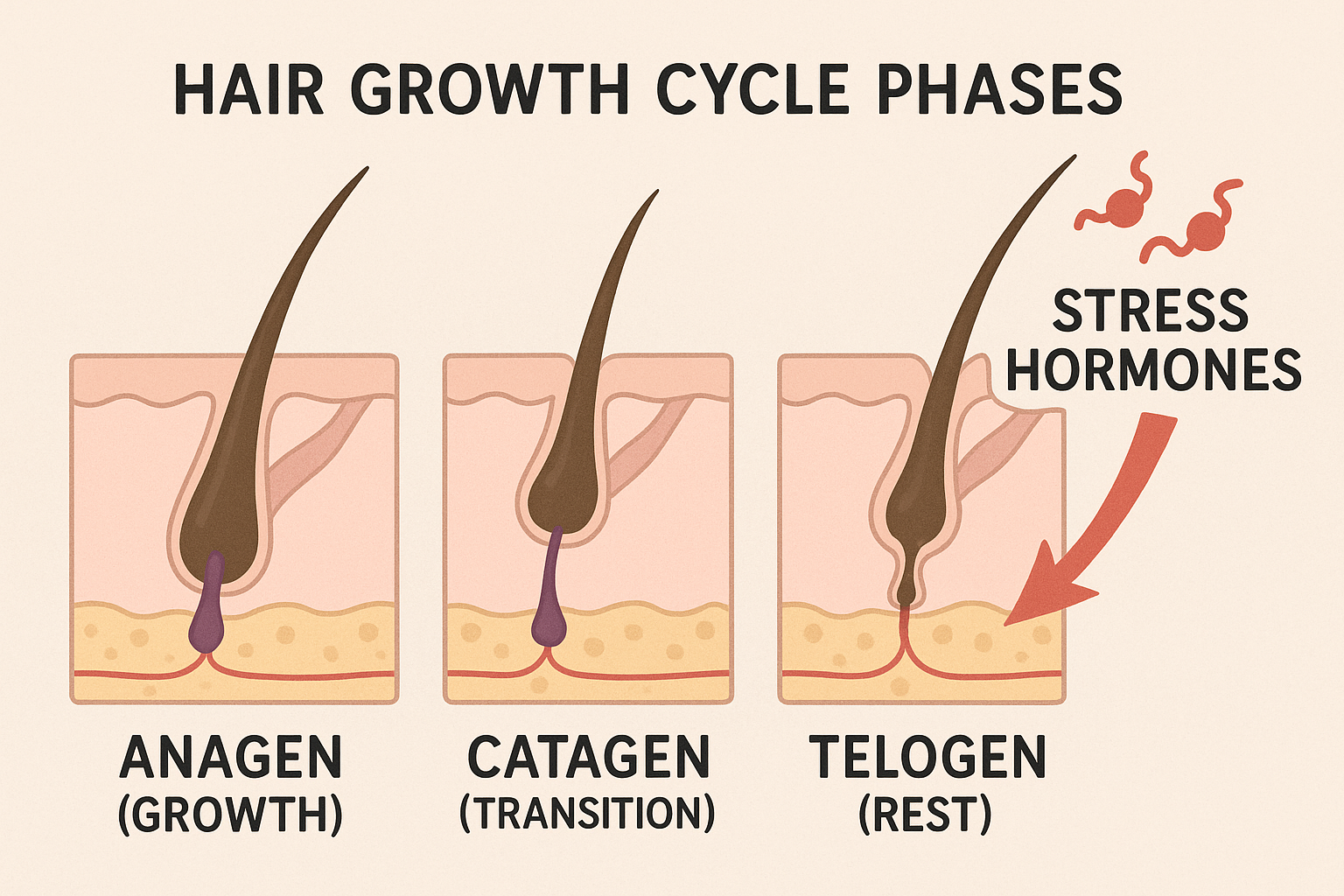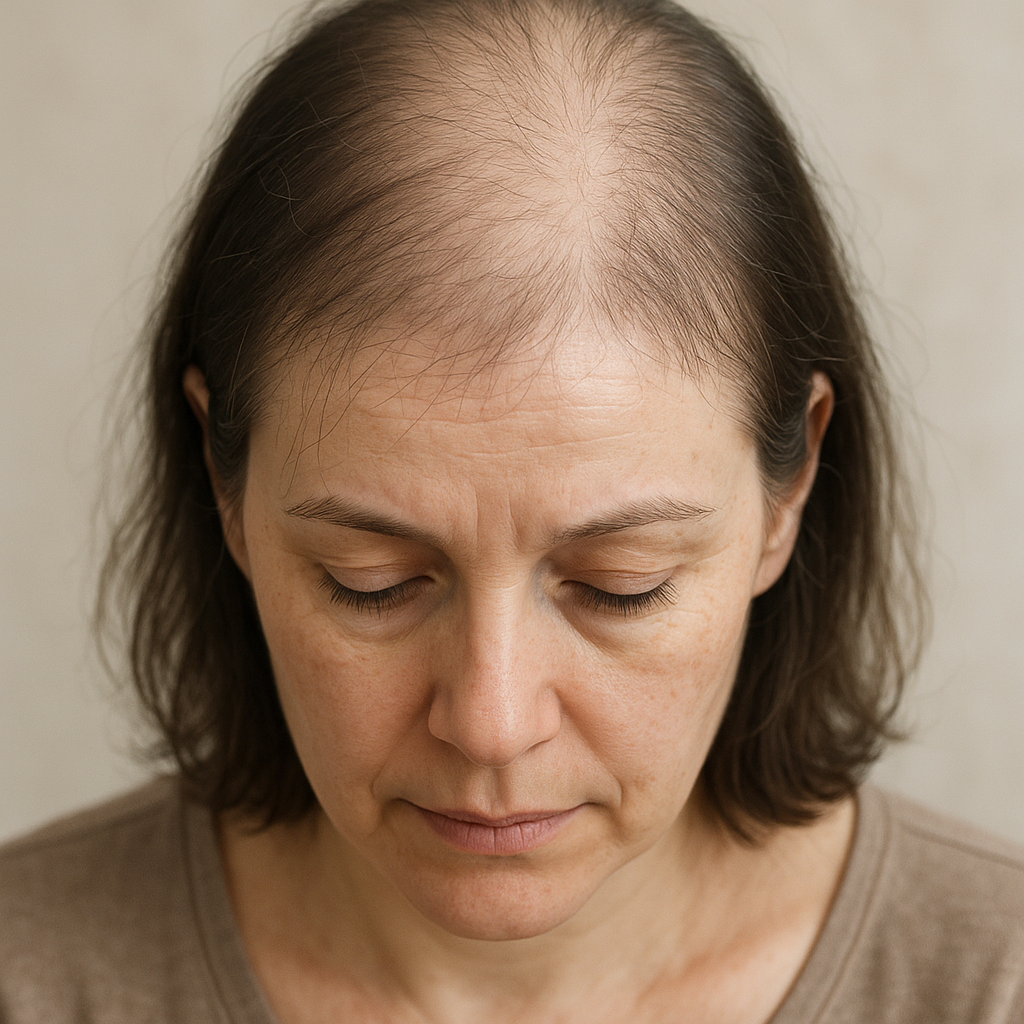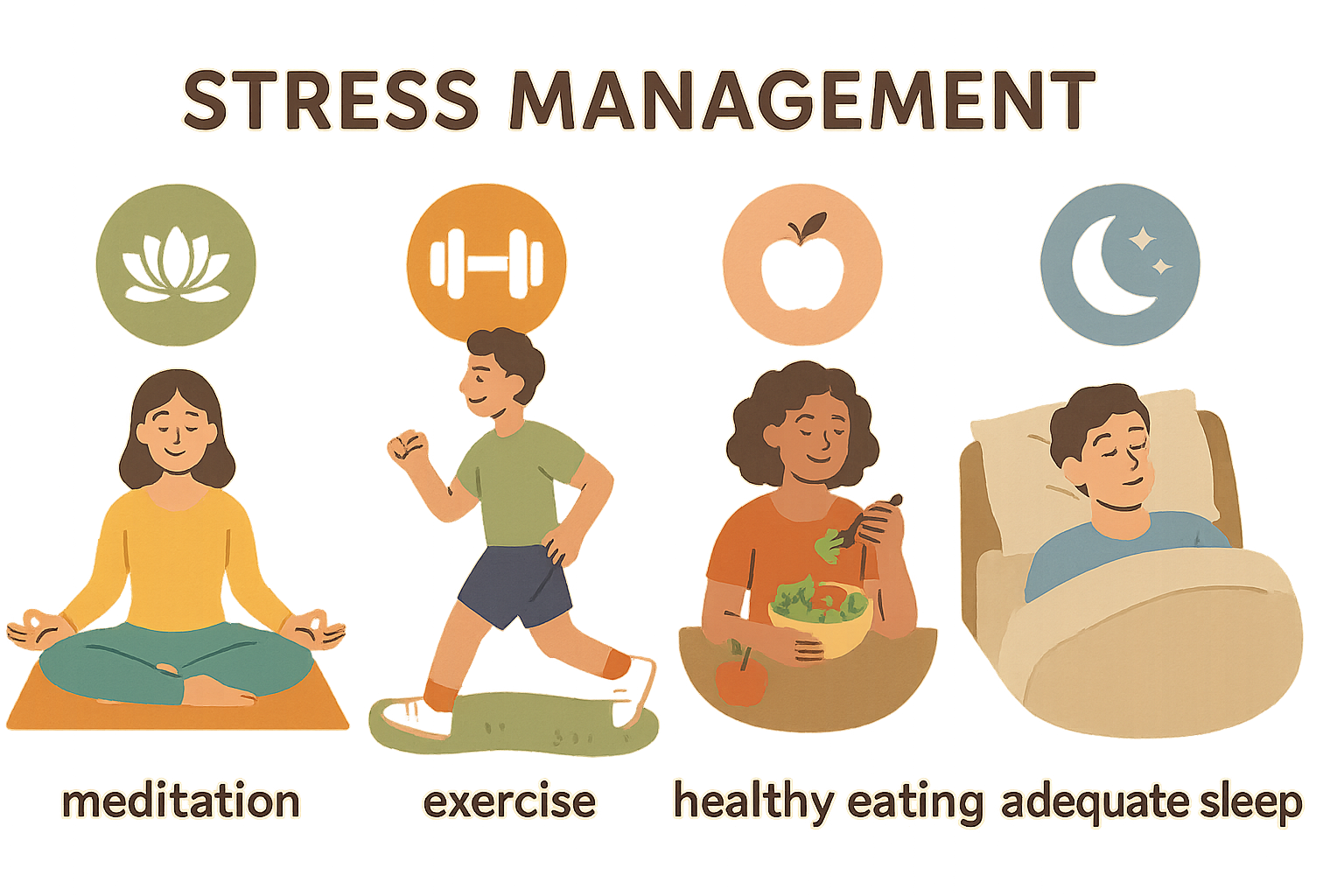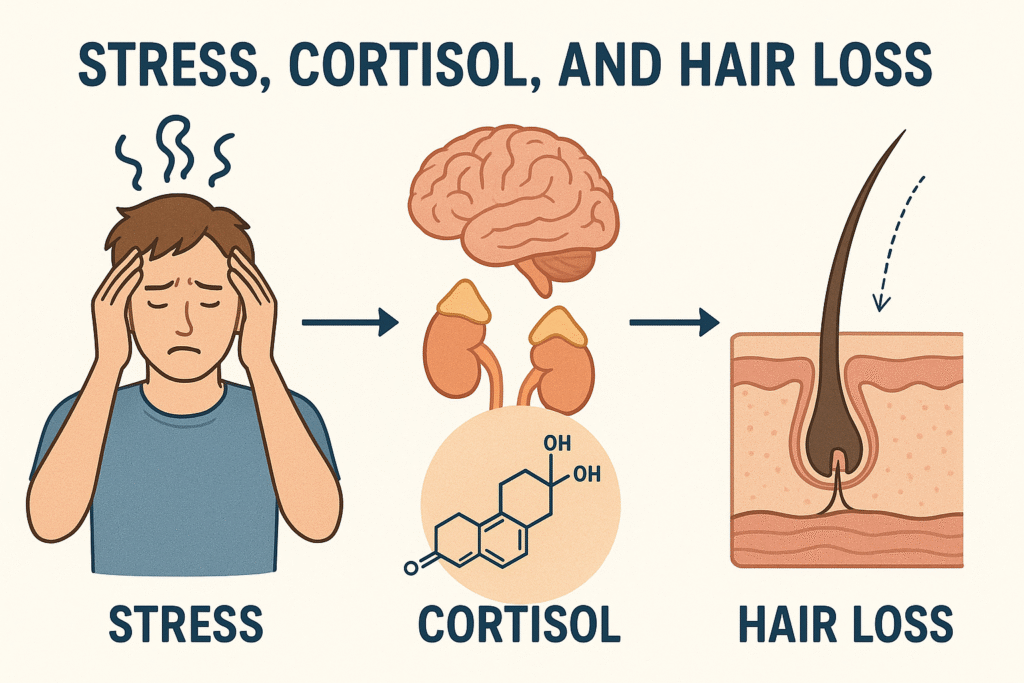Introduction
How Cortisol Causes Stress-Induced Hair Shedding. When you notice more hair than usual on your pillow or in the shower drain during stressful periods, you’re experiencing a well-documented biological response. Stress-related hair loss affects millions of people worldwide, creating a frustrating cycle where hair shedding becomes an additional source of anxiety. The culprit behind this phenomenon is cortisol, your body’s primary stress hormone, which can wreak havoc on your hair health when levels remain elevated for extended periods.
Understanding how stress impacts your hair follicles begins with recognizing that your hair growth cycle operates on a delicate biological schedule. When cortisol levels surge due to chronic stress, this hormone disrupts the normal functioning of hair follicles, forcing them into premature resting phases and ultimately leading to increased shedding. This process isn’t immediate – it typically occurs several months after the initial stressful event, making the connection between stress and hair loss less obvious to many people.
This comprehensive article will guide you through the complex relationship between stress and hair loss, starting with how different types of stress trigger biological changes in your scalp. You’ll discover the specific mechanisms by which cortisol interferes with healthy hair follicle function and learn to recognize the distinctive patterns that indicate stress-induced shedding. Most importantly, you’ll explore evidence-based strategies for managing stress effectively, giving your hair the best possible chance to recover and return to its natural, healthy growth pattern.
Key Takeaways – TL/DR
- Chronic stress elevates cortisol levels, pushing hair follicles into the resting phase prematurely
- Stress-induced hair shedding typically occurs 2-3 months after the stressful event
- Managing stress through lifestyle changes can help restore normal hair growth patterns
- Most stress-related hair loss is temporary and reversible with proper intervention
Understanding the Stress-Hair Loss Connection
The relationship between psychological stress and hair loss represents a complex biological cascade where elevated stress hormone levels disrupt normal hair growth cycles. This connection manifests through various stress types affecting hair follicles, leading to increased hair shedding patterns that can develop weeks to months after the initial stressor.
Types of Stress That Trigger Hair Loss
Physical trauma stress from surgery, accidents, or severe illness can trigger telogen effluvium, causing widespread hair shedding [1]. Emotional stress events such as divorce, job loss, or bereavement create similar disruptions to hair growth patterns through sustained cortisol elevation. Chronic stress from workplace pressures or ongoing personal challenges represents the most problematic category, as persistent stress hormone elevation continuously interferes with normal hair follicle function, leading to prolonged hair loss episodes.
Timeline of Stress-Related Shedding
Stress-related hair shedding follows a predictable timeline, with visible hair loss typically appearing 2-3 months after the initial stressful event [2]. This delay occurs because hair follicles shift from the growth phase into the resting phase before eventual shedding. Peak shedding usually occurs between months 3-6, with recovery beginning around 6-9 months post-stress resolution, assuming no additional chronic stress factors interfere with the natural hair growth cycle restoration.

How Cortisol Disrupts Hair Follicle Function
Cortisol, produced by the adrenal glands during stress responses, directly targets hair follicle stem cells and disrupts their normal regenerative processes [3]. This stress hormone binds to glucocorticoid receptors within the dermal papilla and outer root sheath, triggering a cascade of cellular changes that compromise follicle integrity. Elevated cortisol levels cause hair follicle stem cells to enter a prolonged quiescent state, reducing their proliferative capacity and impairing the normal hair growth cycle.
The hormone also promotes chronic inflammation around hair follicles by activating inflammatory pathways and increasing pro-inflammatory cytokine production [4]. This inflammatory environment creates oxidative stress that damages follicular structures and accelerates the transition from anagen (growth) to telogen phase prematurely. When cortisol levels remain persistently elevated, hair follicles become trapped in the resting telogen phase for extended periods, leading to noticeable hair thinning and eventual miniaturization of follicles throughout affected scalp regions.

Identifying Stress-Induced Hair Shedding Patterns
Stress-related hair loss presents distinct patterns that help differentiate it from other conditions. The most common sign is sudden hair loss occurring uniformly across the scalp, creating diffuse hair thinning rather than localized bald spots. You may notice increased shedding when washing, brushing, or styling, with affected hairs appearing thinner and more fragile than usual.
The distribution pattern typically involves overall density reduction throughout the scalp. However, significant stress can also trigger alopecia areata, presenting as small, round patches of complete hair loss on the scalp or other body areas.
Key indicators include finding more hair on pillows, in shower drains, or on clothing than normal. The affected hairs often appear shorter, weaker, and break more easily. Timeline is crucial for identification – stress-induced shedding typically begins two to three months after experiencing significant stress, making the initial connection between trigger and hair loss less obvious to recognize.

Effective Stress Management for Hair Recovery
Successfully managing stress requires a multifaceted approach that targets both immediate anxiety relief and long-term mental health improvement. Research demonstrates that consistent stress management techniques can significantly reduce cortisol levels, creating optimal conditions for hair follicle recovery [5]. Regular meditation, deep breathing exercises, and progressive muscle relaxation have proven effective in lowering stress levels while promoting psychological resilience.
Physical activity serves as a powerful stress-reduction tool, with studies showing that moderate exercise can decrease cortisol production and improve overall mental health. Establishing consistent sleep patterns, maintaining social connections, and practicing mindfulness-based interventions further support the body’s natural healing processes. Cognitive-behavioral strategies help individuals develop better coping mechanisms when facing stressful situations [6].
The key to successful hair recovery lies in implementing these stress management techniques consistently over time. As cortisol levels normalize through sustained stress reduction efforts, hair follicles gradually return to their natural growth cycle, allowing for healthy regrowth and improved hair density.

Conclusion
The encouraging news is that stress-induced hair loss is typically reversible, offering genuine hope for those currently experiencing this challenging and often distressing condition. When you effectively manage stress levels and reduce cortisol levels through proven techniques like meditation, regular exercise, and adequate sleep, your hair follicles can gradually return to their normal, healthy growth cycle.
Achieving optimal hair health requires a holistic approach that addresses both physical and emotional wellbeing comprehensively. By implementing comprehensive stress management strategies, you’re not only supporting healthy hair growth but also improving your overall quality of life. The journey to restored hair growth may take several months, as hair follicles need sufficient time to recover from prolonged stress exposure and damage.
Remember that maintaining consistent stress management practices is absolutely key to preventing future episodes of stress-related hair loss. Regular exercise, mindful meditation, proper nutrition, and sufficient sleep all contribute to balanced cortisol levels and robust hair health. While seeing hair on your pillow can be distressing, understanding that this condition is temporary empowers you to take decisive control.
Prioritizing your mental health ultimately supports healthy hair, creating a positive cycle where reduced stress levels promote both hair follicle recovery and overall wellbeing, ensuring lasting results for your ongoing hair health journey.
Frequently Asked Questions
Hair typically begins regrowing 3-6 months after stress levels normalize, with full recovery taking 6-12 months depending on the severity of the initial shedding and individual factors.
Most stress-induced hair loss is temporary. However, severe chronic stress or conditions like alopecia areata triggered by stress may require professional treatment for optimal recovery.
Consistently elevated cortisol levels above normal ranges (typically measured through saliva or blood tests) can disrupt hair growth, but individual sensitivity varies significantly.
References
- Malkud S. Telogen Effluvium: A Review. J Clin Diagn Res. 2015;9(9):WE01-WE3.
- Rossi A, Anzalone A, Fortuna MC, et al. Multi-therapies in androgenetic alopecia: review and clinical experiences. Dermatol Ther. 2016;29(6):424-432.
- Thom E. Stress and the hair follicle: exploring the connections. Int J Cosmet Sci. 2016;38(6):569-584.
- Hsu YC, Pasolli HA, Fuchs E. Dynamics between stem cells, niche, and progeny in the hair follicle. Cell. 2011;144(1):92-105.
- Goyal M, Singh S, Sibinga EM, et al. Meditation programs for psychological stress and well-being: a systematic review and meta-analysis. JAMA Intern Med. 2014;174(3):357-368.
- Khoury B, Sharma M, Rush SE, Fournier C. Mindfulness-based stress reduction for healthy individuals: A meta-analysis. J Health Psychol. 2015;20(6):725-735.









